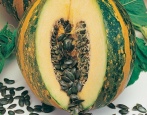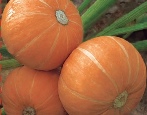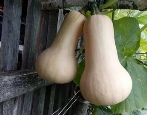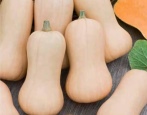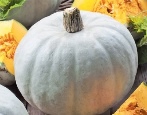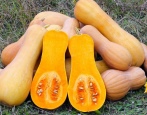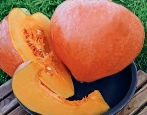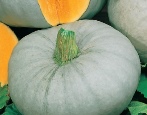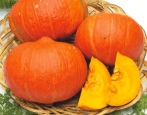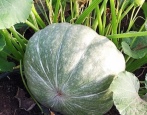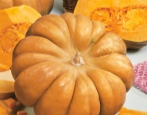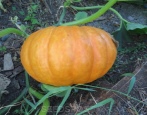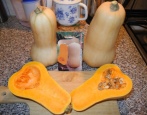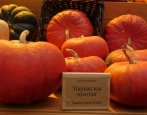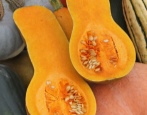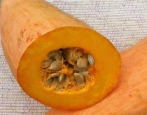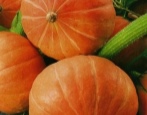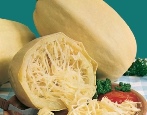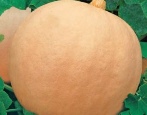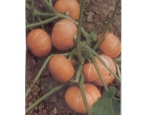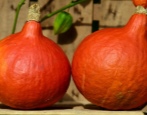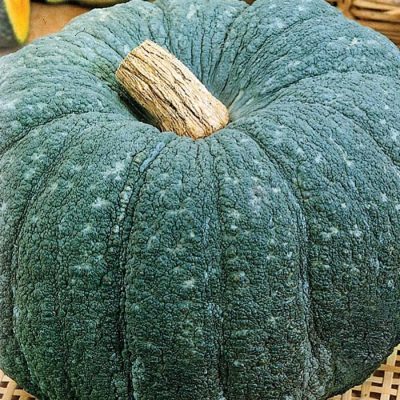
- Year of approval: 1975
- Growth type: powerful
- Leaf color: green
- The form: flattened
- Weight, kg: 4,0-4,2
- Coloration: the background color is gray and dark gray, sometimes with a greenish tint, the pattern is speckled and sometimes flat between the segments, the color of the pattern is light gray
- Color of the pulp: orange
- Pulp (consistency): dense, delicate
- Taste: sweet
- Taste qualities: good and excellent
Pumpkin Marble is a medium-late high-yielding crop capable of forming fruits weighing more than 10 kg. The variety has a segmented structure and an emerald hue. Due to its unpretentiousness and excellent taste, pumpkin has gained popularity in regions with different climatic conditions, but the most juicy and sweet vegetables can be obtained only in climatically warm latitudes. Excellent taste and rich aroma, as well as a rich vitamin composition allows using the fruits both for cooking various dishes and for pickling, canning, drying and freezing.
Description of the variety
Pumpkin Marble - the result of painstaking selection work of specialists of the Federal State Budgetary Scientific Institution "FNTs Rice" (Krasnodar Territory). In 1975, the late-ripening variety was officially registered and entered the wholesale and retail trade. Due to its ease of care, resistance to temperature fluctuations, and a long storage period, the variety has gained popularity in regions with different climatic conditions, and its excellent taste, juicy and sweet pulp make it possible to use the vegetable for making both sweet desserts and side dishes.
Advantages:
high productivity;
resistance to temperature fluctuations;
ease of care;
the formation of large fruits;
universal purpose;
excellent taste indicators;
juicy and sweet meaty texture;
storage period until March;
no significant damage during transportation;
attractive appearance;
resistance to short-term droughts and short-term frosts;
a high level of resistance to the most common diseases and pests;
genetic resistance to cracking.
Disadvantages:
a decrease in taste and the acquisition of a loose structure when grown in cold northern regions;
landing in well-lit areas;
long ripening period;
the formation of a large number of lashes;
very dense leathery cover;
the need for regular feeding;
the need for regular watering.
Characteristics of the appearance of plants and fruits
Pumpkin Marble is a mid-late culture that quickly forms long and branched lashes. Large leaf plates of a deep green shade with an emerald tint are located on thick stems. The structure of the leaves is uniform, without cuts. During the flowering period, the pumpkin forms large flowers of bright yellow colors that attract insects, including pollinators.
Particular attention should be paid to large fruits that have a flattened shape, as well as a wrinkled leathery cover - its basic shade is greenish-emerald, with gray spots and veins. The entire surface of the vegetable is divided into small pieces that make the variety unusual and attractive. The weight of ripe fruits is in the range from 4.0 to 4.2 kg. But there are also larger specimens.The subcutaneous fleshy part is colored deep orange and has a dense but delicate structure. The ripe vegetable has a pleasant sweetish aftertaste. The unique chemical composition of pumpkin consists of the following elements:
dry matter - 14-18%;
sugar - 8.5-9%;
carotene - 4-15;
potassium;
magnesium;
vitamins A, B, E.
Purpose and taste
Due to its juicy, fleshy and aromatic structure, pumpkin has a universal purpose and is used for preparing fresh salads, soups, side dishes, sweet desserts and casseroles. The vegetable can be canned, pickled, dried and frozen. In ripe pumpkin, acid and bitter notes are completely absent. Due to its low calorie content and rich vitamin composition, culture is an integral part of the diet of people who monitor their health and are on a diet. Despite the long storage period, by the spring pumpkin loses some of its vitamins and becomes less useful, but the vegetable does not lose its aroma and nutmeg notes.
Ripening terms
Harvesting of a medium late crop begins after 131-139 days from the moment the first shoots appear. The ripening time of fruits directly depends on the climatic conditions of the region of cultivation, as well as seasonal weather conditions. Harvesting occurs mainly in late August or early September.
Yield
Pumpkin Marble refers to high-yielding varieties. On average, it is able to form on a site of 1 hectare from 15.8 to 29 tons of juicy, large and sweet fruits. On small household plots, up to 20 kg of pumpkin ripens per 1 m2. The amount of the harvested crop depends not only on the region of cultivation, but also on the observance of all agrotechnical features of crop cultivation, as well as on seasonal weather conditions.
Growing and care
To obtain a high-quality harvest of the required amount when growing medium-late pumpkin, you must adhere to the following agrotechnical rules:
compliance with crop rotation;
carrying out regular weeding and removing weeds;
thinning out the site;
disinfection of seed;
moistening the soil;
soil enrichment with mineral and organic fertilizers.
Before opting for a late-ripening variety, you need to pay attention to the fact that you can get a fully ripe harvest of sweet and aromatic pumpkin only in regions with warm climatic conditions. To obtain seedlings in the third decade of April or the first decade of May, it is necessary to plant seeds. When grown outdoors, sowing seeds should be carried out in late May - early June. During this period, you can engage in transplanting seedlings to a permanent place.
When choosing a site for a pumpkin, preference should be given to well-lit areas, protected from strong currents of cold winds. The maximum amount of crops can be harvested when the crop is grown on fertile soils with neutral acidity levels. Before sowing, the seeds must be soaked and treated with growth stimulants. The standard planting scheme is 100 by 100 cm. The minimum distance between plants should not be less than 70 cm. The sowing depth is not more than 5 cm. In well-shed holes, 2-3 seeds should be planted. One month after the emergence of sprouts, all weak plants must be removed.
Cultural care consists of a set of classic activities. For a quick set of green mass and the formation of plant fruits, it is necessary to water abundantly at least 3-4 times a week. To prevent the development of fungal infections, pour water strictly under the root, avoiding contact with the leaves.
Regular loosening of the soil, as well as the removal of weeds, will help to enrich the root system with oxygen and accelerate the growth of bushes. One should not forget about mulching the root zone, as well as the regular enrichment of the soil with mineral and organic fertilizers.
Mass harvesting can be carried out only after wilting of deciduous green mass, as well as drying and woody stalk.The leathery cover of a ripe pumpkin should acquire a varietal shade. Harvesting fruits must be carried out on sunny and warm days before the first frost occurs, the effect of which can significantly reduce the storage period of the vegetable.
Disease and pest resistance
Despite its unpretentiousness and resistance to the most common diseases, if the agrotechnical rules for cultivation and care are not followed, areas with Marble Pumpkin can be affected by the following diseases:
powdery mildew;
white and root rot;
bacteriosis.
Pests such as spider mites, melon aphids and slugs can reduce the amount of the crop and spoil the presentation of the fruit.
And also one should not forget about carrying out regular preventive treatment of plants with special chemical and biological preparations.
